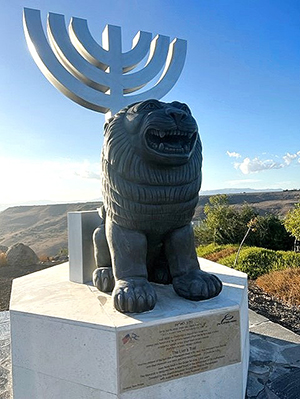Editor’s Note: A trail of biblically important sites throughout Israel has been marked with ten 9-foot high statues of a lion, donated by the Jewish American Society for Historic Preservation. In this series, JASHP President Jerry Klinger tells the story behind each of the sites, traveling from the Golan to Dimona.
By Jerry Klinger


EIN KESHATOT, Golan Heights, Israel — “The Lion’s Trail – Golan” sculpture is located adjacent to the Israeli National Historical site of Ein Keshatot, “Spring of the Arches.” It is a “hidden” Jewish archeological treasure, a huge, reconstructed synagogue from the sixth century, high up in the Golan Heights. The dedication plates on the nine-foot tall sculpture is unfinished because of evacuations ordered in parts of northern Israel susceptible to Hezbollah missiles from Lebanon and mortars from Syria.
The site was correctly documented by proto-Christian Zionist Laurence Oliphant in 1884. He trekked across the largely depopulated Golan Heights plateau on a mission of exploration to identify Judeo-Christian biblical sites in Ottoman Palestine. It was not all that hard for Oliphant to recognize the ruins as having been a synagogue. Though it had been more than a thousand years since the great earthquake of 749 destroyed the site, Oliphant clearly saw a Menorah carved unto one of the remaining Corinthian, still standing, columns next to an Oron HaKodesh, a Holy Ark, where Jews had stored their Torahs.
The earthquake did not just destroy the synagogue at Ein Keshatot. It destroyed more than 30 synagogues that existed in the Golan, and possibly the same number of Churches.
The Golan Heights had been a significant area of Jewish life. After the earthquake, Jews could not and were not permitted to return to live in the Golan by the occupying Muslim powers and later the Ottoman Turks. Jews could not return to live in the Golan until after the Israeli victory over the Syrians in the 1967 war.
The placement of the Lion’s Trail Golan sculpture was made possible because of an opportunity created by a mistake. An innocent, unintentional cultural misunderstanding, certainly not intended to create dissension, had placed a controversial, religiously interpreted, sculptural gift near Ein Keshatot. Anger prevailed over reason. The sculpture was removed within two weeks of its unveiling.
What was left behind was a significant elevated sculpture base, stone paved foundation and the magnificent, photogenic view of the Galilee spreading below. It was worth thousands of dollars. It would also be torn down unless it could be suitably repurposed.
Having visited Ein Keshatot, and not being involved in the incident, I did not suffer the embarrassment and ill feelings of others. I recognized an opportunity to tell a story of Jewish historical legitimacy and presence that was roiling then and still does today.
Anti-Israel political narratives deny Jews lived in the Golan. Some reluctantly admit a few Jews may have lived a long time ago in the Golan, but they are long gone. Pseudo-historians insist, Jews returning are occupiers, thieves, and usurpers. Their quasi-River to the Sea, Palestine Must be Free (of Jews) slogan is politically popular.
The argument was and is absurd.
Benny Kashriel, the past mayor of Ma’ale Adumim, shared with me, his community is living on Jewish land cited in the book of Joshua. “Jews,” he said, “have lived here for over 3,000 years. There is no question about Jews, Jewish historical legitimacy, and the land.”
The thought stuck. I wondered if the same is true about the Golan.
Jews living in the Golan are referenced in the Old Testament, the Book of Joshua, the Book of Chronicles, the Psalms, even the New Testament.
An idea crystalized: could the empty sculpture platform be used to place something interpreting Jewish historical legitimacy and the land?
I shared my idea with Sam Philipe, an internationally recognized sixth-generation Jerusalemite, sculptor, and friend. We have worked together for years to fill in the holes of Jewish memory through art and artistic interpretation. His interest is purely art. He has worked with Jews and across the spectrum. My interest is messaging.
I asked Sam to approach the Golan Regional Council about using the empty platform base if the right sculptural messaging can be achieved. They agreed only if they could approve the sculptural interpretation. They wanted no misunderstandings again.
My requirement was simple –a plaque – with a quote from the Bible and wording about Jews having lived in the Golan for over 3,000 years.
Sam came back with a design of a large open Magen David that people could see through to appreciate the Galilee below. I rejected the idea – too pedestrian.
Sam next suggested a large, artistically beautiful, golden David’s Harp. I rejected the idea. It does not immediately evoke any message except art.
We went back and forth on how to tell the story of the Jewish Golan. The answer was right in front of us, Oliphant had shown us the way; the Menorah on the Corinthian column.
Sam suggested a seven-foot-high menorah modeled on the Menorah of the Ein Keshatot synagogue. Again, I felt it needed more. It lacked the power of projection.
“Sam, what is the symbol of the House of David?” “The Lion of Judah,” he responded. “The Lion of Judah is a symbol recognized for its power and identified with the land of Israel,” I said.
The artist took the input and came back after extensive research with a proposal, the giant Menorah on the base with a lion sitting in front. Lions lived in the Golan.
Scouring museums, Sam found a model, a Hittite Lion. It was unique. It was powerful. It was an artistic opportunity. It would attract eyes and legs to see it. The messaging would be on the plates below.
The Golan Council agreed.
Much time progressed. My idea expanded into a national project. What if we could create a Lion’s Trail, with a Lion of Judah throughout Israel? Wherever the Lion of Judah was found, was a part of biblical Israel. They all would have a quote from the bible about the location. The Lions of the Lion’s Trail would all be big – 9-feet plus.
The Golan Lion’s fabrication dragged on slowly, delayed with social and political caution. The Lion’s Trail, a tourism network of adventure and history, developed.
Ten Lions have been placed so far, from the Golan to Dimona in the South.
The Golan Lion is almost complete. It is still missing the second and most important plaque, President of the United States, Donald Trump’s 2019 recognition, “the Golan is part of Israel.” Lighting and a pathway to Ein Keshatot Park have not been completed.
Tens of thousands of visitors used to come to Ein Keshatot before October 7, 2023. Today, no one comes.
The danger of missile attack from Hezbollah or from the Syrians is very, very real. The area is closed, even to Israelis.
When peace can finally return, the Lion and the plaque will be completed. Below is its wording.
Lion’s Trail – Golan
“And the children of the half-tribe of Manasseh dwelt in the land: they increased from Bashan unto Baal-Hermond and Senir, and unto Mount Hermon.” I Chronicles 5:23
| כג וּבְנֵי, חֲצִי שֵׁבֶט מְנַשֶּׁה, יָשְׁבוּ, בָּאָרֶץ; מִבָּשָׁן עַד-בַּעַל חֶרְמוֹן, וּשְׂנִיר וְהַר-חֶרְמוֹן–הֵמָּה רָבוּ. |
The Menorah is modeled on the Menorah carved in the ancient Ein HaKeshatot Synagogue.
Jews have lived in the Golan for over 3,000 years.
Donated by the Jewish American Society for Historic Preservation with support from the Golan Regional Council
JASHP Logo – Golan Logo
*
Seal of the President of the United States
March 25, 2019
“The United States recognizes the Golan Heights are part of the State of Israel.”
President Donald J. Trump
*
Jerry Klinger is the President of the Jewish American Society for Historic Preservation. www.JASHP.org